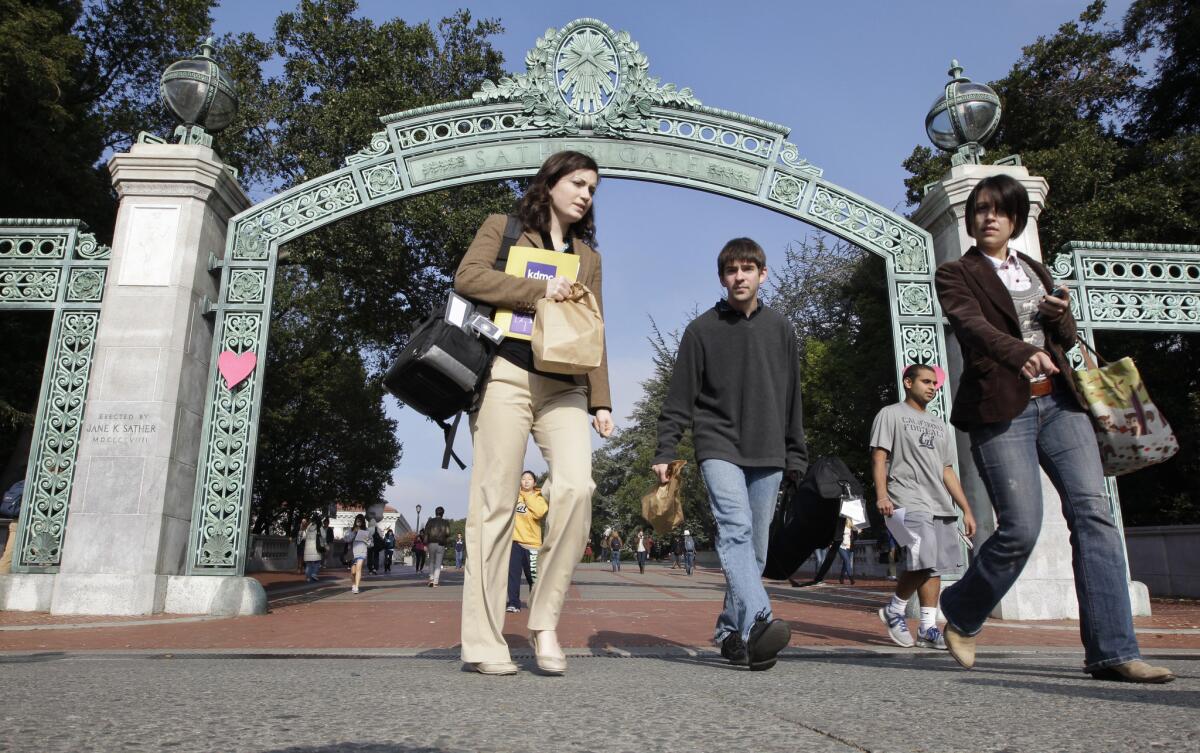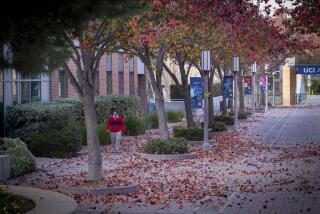Editorial: A battle for UC’s soul

The current tension over proposed tuition hikes at the University of California — as much as 5% each year for the next five years — shouldn’t be mistaken for just another debate about how much students can or should pay. It’s nothing less than a battle for UC’s soul.
At issue is whether the 10-campus system will continue to rank among the nation’s premier research universities, drawing top students and the best professors from throughout the world, or whether it will slowly shrink its ambitions, becoming a more utilitarian institution that concentrates narrowly on moving students to their bachelor’s degrees and into the workforce quickly and efficiently.
UC President Janet Napolitano says that she will ask the Board of Regents to approve the tuition increases Wednesday, although they would not have to go into effect if the the state provides better funding. Gov. Jerry Brown, who opposes the tuition hikes, points out that he is already planning on increasing the state’s contribution 4% a year over the next two years, though he wants to tie those increases to some major changes. Among his suggestions: more online courses, heavier teaching loads for professors, reductions in nonessential research, the admission of a smaller proportion of freshmen and more community college transfers, so that the state can educate college students more inexpensively for their first two years.
Brown isn’t wrong to ask UC to look for new efficiencies and savings. But the governor isn’t giving adequate recognition to UC’s historic and current role within the state’s three-tier college system, or to its significance as an economic engine for the state. Under the Master Plan for Higher Education, community colleges provide vocational education, two-year associate’s degrees and a transfer path to four-year colleges. California State University was set up as a four-year teaching college system. And the University of California was to be the jewel in the crown — a world-class research university system to teach the state’s top undergraduates and PhD students, to train doctors and lawyers, to conduct groundbreaking research and publish scholarly work.
UC has lived up to the vision. UC Berkeley is ranked by many organizations as the top public university in the world. UCLA is usually close behind, and four other UC campuses are typically within the top 15 or 20. UC’s faculty and researchers have won 62 Nobel prizes. Unlike the Northeast, the West Coast does not have a large collection of elite private colleges and universities; UC has filled the gap. Along the way, it has helped give rise to the computer and biotech industries, among others. A regents-commissioned 2011 study found that for every dollar the state invests in the university, it creates close to $10 in gross state product.
Yet the contribution of state taxpayers has been dropping steadily over the years, threatening UC’s ability to carry out its mission. In 2005, the state paid for about 60% of each student’s tuition; families paid 40%. Those numbers are now reversed. State funding today is still about $460 million below where it was in 2007-08 (despite a $140-million increase in 2014). Of course, UC cannot expect quick restoration to its pre-recession funding levels. But the state is falling far short of what it needs to give if UC is to retain its luster, and Brown’s 4% proposal is insufficient to make up the difference.
UC, to its credit, has found ways to make ends meet without significantly compromising the quality of education. It admits far more students from out of state than it used to, each of whom pays much higher tuition and thus helps subsidize aid for in-state students. It has also centralized purchasing and other administrative functions, which saves about $150 million a year. But in coping with budget cuts, UC also has had to hire more adjunct teachers, and students are often shut out of courses they want or need.
Even as state funding plummeted 25% during the recession and course offerings faltered, UC continued to achieve. It increased in-state enrollment by 7,000 students and reduced the time it takes the typical student to graduate. Among undergraduates, 40% are the first in their family to attend college, and 25% come from households in which no English is spoken. More than half of UC undergraduates — those whose families earn less than $75,000 — pay no tuition whatsoever. About 70% are on some financial aid.
A report this month by the Public Policy Institute of California says that UC’s tuition increases over the last 20 years are not the result of lavish spending. Institutional expenses, including salaries, have not risen substantially. Rather, the increases have resulted from a steady loss of state support.
The governor’s response to UC’s funding proposal has not been helpful. Online courses can be a useful part of a student’s education, but when done right, they don’t save significant money. As for transfer students, close to a third of the new students at UC each year are community college transfers. But UC should not be pressed to become mostly a two-year undergraduate program, enrolling transfers for junior and senior years. Students seeking a top four-year university would flee the state. And professors should not be required to reduce research or publication, lest the state lose them as well.
No one wants a tuition increase, but it’s worth remembering that even with the price hike, which would bring tuition and fees to about $15,500 after five years, UC would still be less expensive than other top-ranked public universities such as the University of Virginia. The money would allow the university to offer more courses, reduce class sizes, enroll 5,000 more students and still offer full financial packages to 55% of them. In addition, families with incomes of up to $150,000 would receive financial help through the state’s middle-class scholarship program. The increases may be necessary to protect the university.
But they are not an ideal solution. A better outcome would be for the state to fulfill its historic commitment to excellence and access so that tuition doesn’t have to be raised as much as Napolitano has proposed. Better funding for UC is a wise investment in the state’s future.
When the Board of Regents meets this week, it should support Napolitano’s plan. What state leaders should be figuring out is not how to diminish UC‘s role, but how to preserve UC as a national example of great public higher education.
Follow the Opinion section on Twitter @latimesopinion
More to Read
A cure for the common opinion
Get thought-provoking perspectives with our weekly newsletter.
You may occasionally receive promotional content from the Los Angeles Times.










